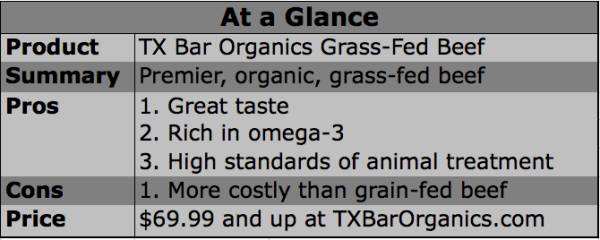
Over the past few years of taking on clean eating, I’ve become quite carnivorous. In my previous life as a side-dish super fan, I enjoyed meat, but didn’t necessarily embrace it. These days I’ve grown a remarkable love for animal protein, especially beef. When I caught word that I’d be receiving some grass-fed beef from TX Bar Organics, I just about did a somersault. Not only do I enjoy meat, but quality, grass-fed beef is something I am always willing to pay for.
TX Bar Organics raise their cattle 120 miles north of Sacramento, in Northern California. With a great deal of pride in taste and quality, TX Bar Organics is recognized by the Global Animal Partnership (GAP) with a “Step 4” rating. The GAP is non-profit organization that is most often associated with their colored 1-5 Step rating system seen in Whole Foods meat counters. Step 4 is an impressive distinction that indicates animals on the farm are pasture centered and get to roam freely. Herein lies the grass-fed value that helps differentiate TX Bar Organics from other meat producers.
If you’re not as passionate about meat as I am, you may be wondering what the big deal about grass-fed, organic meat is. Does it taste better? Is it healthier? And, why is it more expensive?
The cost of meat is driven down significantly as commercial farmers consolidate cattle living quarters, cheapen their food supply with grains, and get them to slaughter weight faster with drugs and an unnatural diet. Grass-fed meat shuns these commercial practices and, as a result, is more expensive than traditional factory farmed beef. Grass-fed cattle take up more space roaming the land freely and by eating a normal grass diet they take more time to grow into full size. These costs are reflected in the price you see as a consumer.
Morally, one could agree that grass-fed cattle live a more healthy, natural life; whereas factory farmed cattle have a bit less humane experience. In addition to moral motives to support grass-fed meat, there is a nutritional advantage to consuming grass-fed meats, as well.
Cows are ruminants. They are meant to eat grass. When cows consume cost-saving grains, their health conditions suffer. Grain-fed cows have a much higher fat content and are often put on a number of antibiotics to help relieve the damaging inflammatory effects of their diet. How these animals are fed has an effect on the omega-3 and omega-6 levels inside the meat. Grain-fed beef is much more rich in pro-inflammatory omega-6, whereas grass-fed cattle are higher in omega-3, which is known for its anti-inflammatory properties. When you eat meat you also consume the fatty acids inside, so by choosing grass-fed beef you choose a less inflammatory diet.
As for the taste, grass-fed beef has been described as having more of a “gamey” taste. For some, this is a more natural and desired taste, while other palettes prefer more fatty meat like grain-fed beef. In my opinion, any taste issues are a matter of previous experience. Folks that tend to favor grain-fed meat over grass-fed meat by taste are likely doing so because it is what they’re used to.
With specific regards to TX Bar Organics, I tried the ground beef, the rib eye, and the top sirloin. All three were incredible; especially considering I just lightly seasoned them with salt and pepper. I also enjoy beef medium rare. It’s wonderful to enjoy beef for it’s own taste rather than drowning it out with overpowering seasonings and marinades, or overcooking it. With quality meats, I find that there’s less reason to do that.
In my opinion, eating quality meats like that of TX Bar Organics has a value beyond incredible taste. Understanding the quality standards by which TX Bar Organics’ products are produced coupled with the health benefits of grass-fed beef makes for a confident consumer. I would love to see what the world would look like if we, as consumers, forced the rest of the meat industry to meet the standards set by TX Bar Organics.
Mixed meat packages are available at txbargrassfed.com.






